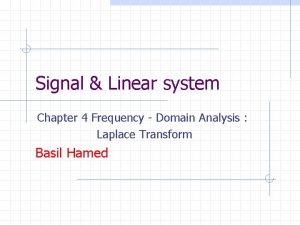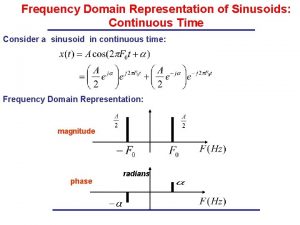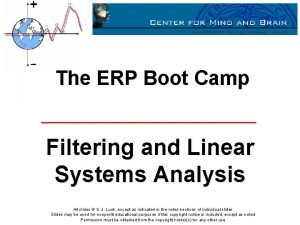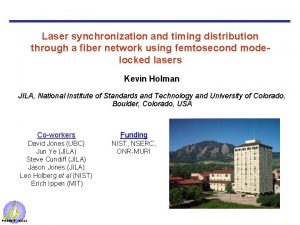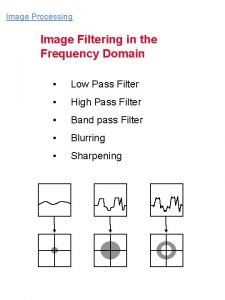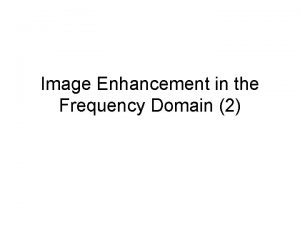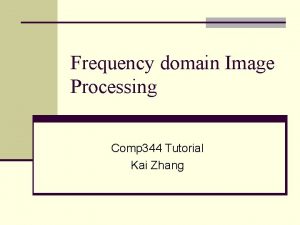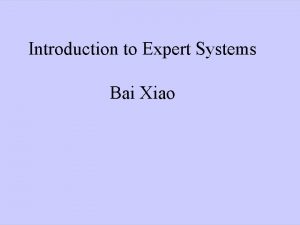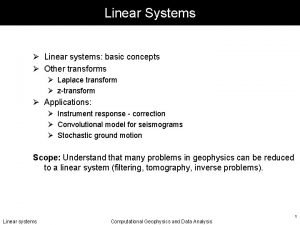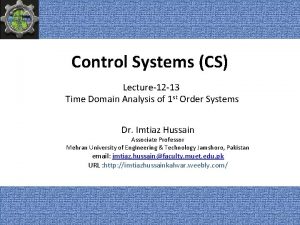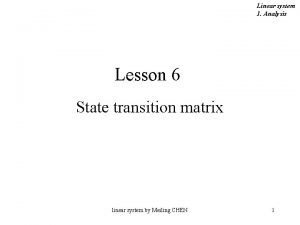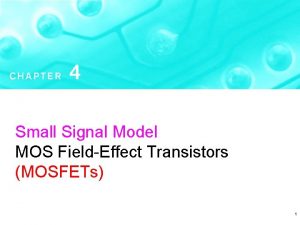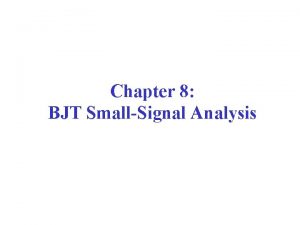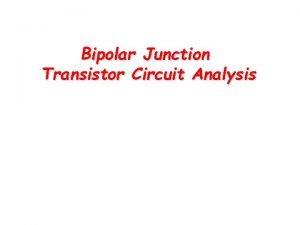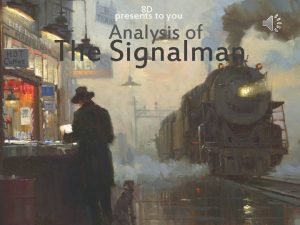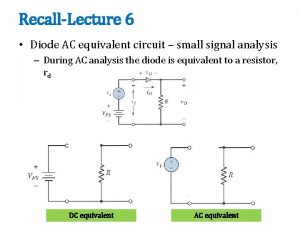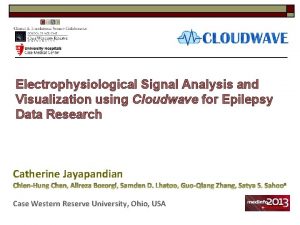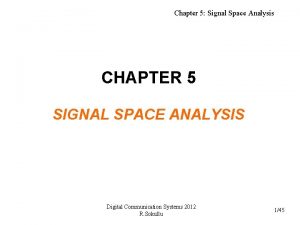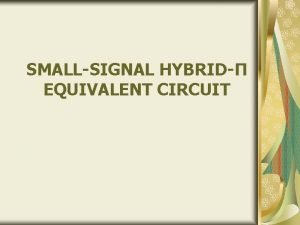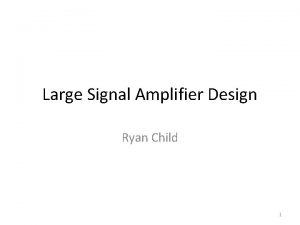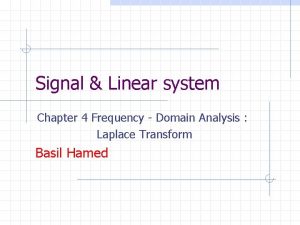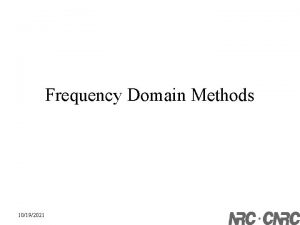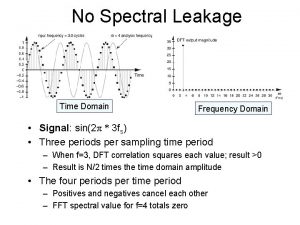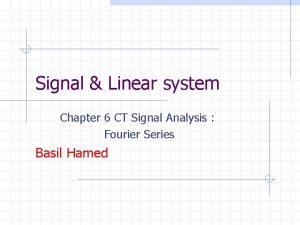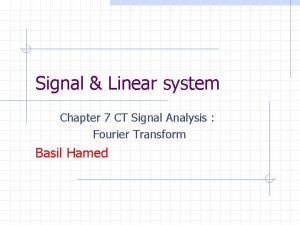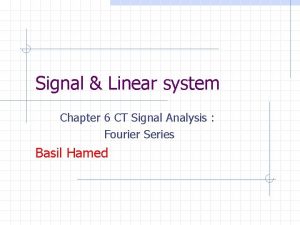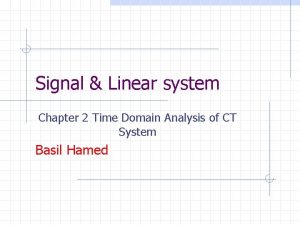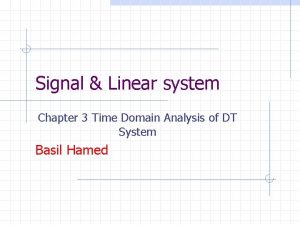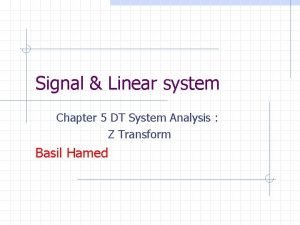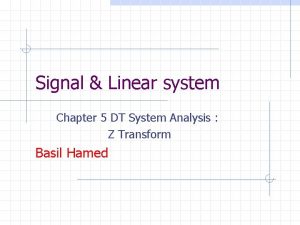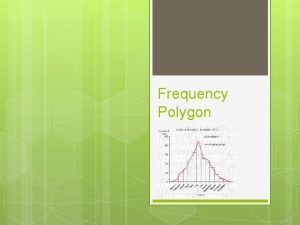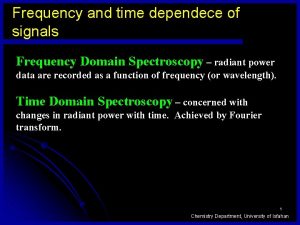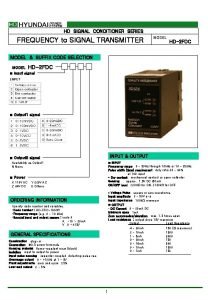Signal Linear system Chapter 4 Frequency Domain Analysis


















































- Slides: 50

Signal & Linear system Chapter 4 Frequency - Domain Analysis : Laplace Transform Basil Hamed

4. 1 The Laplace Transform Basil Hamed 2

4. 1 The Laplace Transform Basil Hamed 3

4. 1 The Laplace Transform Basil Hamed 4

4. 1 The Laplace Transform Laplace transform is the tool to map signals and system behavior from the time-domain into the frequency domain. Bilateral This general definite is known as two-sided (or bilateral) Laplace Transform. Basil Hamed 5

4. 1 The Laplace Transform Basil Hamed 6

4. 1 The Laplace Transform The range of values for the complex variable S for which the Laplace transform converges is called the Region of Convergence (ROC) Basil Hamed 7

4. 1 The Laplace Transform Therefore, in order for the Laplace transform to be unique for each signal x(t). The ROC must be specified as part of the transform Basil Hamed 8

4. 1 The Laplace Transform Basil Hamed 9

4. 1 The Laplace Transform -2<Re{s}<1 Re{s}>-2 Re{s}<1 Basil Hamed 10

4. 1 The Laplace Transform Basil Hamed 11

4. 1 The Laplace Transform Basil Hamed 12

4. 2 Properties of Laplace transform Basil Hamed 13

4. 2 Properties of Laplace transform Basil Hamed 14

4. 2 Properties of Laplace transform Shifting in the S Domain Basil Hamed 15

4. 2 Properties of Laplace transform Time Scaling Differentiation & Integration in the Time Domain Basil Hamed 16

4. 2 Properties of Laplace transform Basil Hamed 17

4. 2 Properties of Laplace transform Differentiation in The S-Domain Basil Hamed 18

4. 2 Properties of Laplace transform Convolution Solution Y(s)=X(s)H(s) Basil Hamed H(s)=Y(s)/X(s) 19

4. 2 Properties of Laplace transform Initial-Value Theorem This property is useful, since it allows us to compute the initial value of the signal x(t) directly from the Laplace transform X(s) without having to find the inverse x(t) Basil Hamed 20

4. 2 Properties of Laplace transform Final-Value Theorem § Final-value Theorem exists only if the system is stable § Final-value Theorem is useful in many applications such as control theory, where we may need to find the final value(steady-state value) of the output of the system without solving for time domain Basil Hamed 21

4. 2 Properties of Laplace transform Basil Hamed 22

Stability conditions for an LTIC system § Asymptotically stable if and only if all the poles of H(s) are in left-hand plane (LHP). The poles may be repeated or nonrepeated. § Unstable if and only if either one or both of these conditions hold (i) at least one pole of H(s) is in right-hand plane (RHP) (ii) repeated poles of H(s) are on the imaginary axis § A system is said to be “marginally stable” if it has at least one distinct pole on the jω axis but no repeated poles on jω Marginally breaks Basil Hamed 23

Stability Basil Hamed 24

Inverse Laplace Transform The function X(s) has to be a proper rational function to find the inverse of Laplace transform. The basic procedure is to express X(s) as a summation of terms whose inverse Laplace transform are available in a table. There are four general forms of solving the partial fraction; the roots of D(s) are either: 1. Real and Distinct 2. Complex and Distinct 3. Real and Repeated 4. Complex and Repeated Basil Hamed 25

Inverse Laplace Transform Real simple Poles Basil Hamed 26

Inverse Laplace Transform Basil Hamed 27

Inverse Laplace Transform Repeated Real Poles Basil Hamed 28

Inverse Laplace Transform Simple Complex Poles Basil Hamed 29

Inverse Laplace Transform Basil Hamed 30

Inverse Laplace Transform Basil Hamed 31

Inverse Laplace Transform Repeated Complex Poles Basil Hamed 32

Inverse Laplace Transform Basil Hamed 33

4. 3 Solution of Differential & Integro. Differential Equations The Laplace transform of differential equation is an algebraic equation that can be readily solved for Y(s). Next we take the inverse Laplace transform of Y(s) to find the desired solution y(t) Basil Hamed 34

4. 3 Solution of Differential & Integro. Differential Equations Time Domain Laplace (Frequency) Domain Basil Hamed 35

4. 3 Solution of Differential & Integro. Differential Equations Basil Hamed 36

4. 3 Solution of Differential & Integro. Differential Equations Zero-input & Zero-state Responses The Laplace transform method gives the total response, which include zero-input and zero state components. It is possible to separate the two components if we so desire. Let’s think about where the terms come from: Input term Initial condition term Basil Hamed 37

4. 3 Solution of Differential & Integro. Differential Equations Basil Hamed 38

4. 4 Analysis of Electrical Networks Output Input Basil Hamed 39

4. 4 Analysis of Electrical Networks We’ve seen that the system output’s LT is: So, if the system is in zero-state then we only get the second term: ⇒System effect in zero-state case is completely set by the transfer function Basil Hamed 40

4. 4 Analysis of Electrical Networks Poles and Zeros of a system Given a system with Transfer Function: We can factor B(s) and A(s): (Recall: A(s) = characteristic polynomial) Pole-Zero Plot This gives us a graphical view of the system’s behavior Basil Hamed 41

4. 4 Analysis of Electrical Networks Example Basil Hamed 42

4. 4 Analysis of Electrical Networks S- Domain Time Domain Basil Hamed 43

4. 4 Analysis of Electrical Networks Basil Hamed 44

4. 4 Analysis of Electrical Networks Gramer rule yields Basil Hamed 45

4. 4 Analysis of Electrical Networks Solution: The Loop Eq. are Basil Hamed 46

4. 4 Analysis of Electrical Networks Gramer’s rule yields Basil Hamed 47

4. 5 Block Diagrams • Large systems may consist of an enormous number of components or elements. Analyzing such systems all at once could be next to impossible. In such cases, it is convenient to represent a system by suitably interconnected subsystems. • Each subsystem can be characterized in terms of its input-output relationships. Basil Hamed 48

4. 5 Block Diagrams X ( s) H 1 ( s) W ( s) H( s) Y( s ) H 2 ( s) Y( s ) = X ( s) H 1 ( s) + H 2 ( s) Y( s ) = X ( s) G(s) 1 + G ( s) H( s) Y( s ) H 1 ( s) X ( s) H 2 ( s) X ( s) - E( s ) G ( s) H( s) 49

4. 5 Block Diagrams Example: A basic feedback system consisting of block find TF More on this later in Control Course feedback 50
 Z domain to frequency domain
Z domain to frequency domain Frequency domain to time domain
Frequency domain to time domain Time reversal property of z transform
Time reversal property of z transform Z transform online
Z transform online Vmax=aw
Vmax=aw Baseband signal and bandpass signal
Baseband signal and bandpass signal Baseband signal and bandpass signal
Baseband signal and bandpass signal Digital signal as a composite analog signal
Digital signal as a composite analog signal The product of two odd signals is:
The product of two odd signals is: How to find conditional relative frequency
How to find conditional relative frequency Probability with relative frequency
Probability with relative frequency Average of sine wave
Average of sine wave Relative frequency bar chart
Relative frequency bar chart Joint frequency vs marginal frequency
Joint frequency vs marginal frequency Relative frequency table
Relative frequency table Laplace frequency domain
Laplace frequency domain Time frequency domain
Time frequency domain Fourier transform time shift
Fourier transform time shift Circular convolution is commutative
Circular convolution is commutative Time frequency domain
Time frequency domain Time frequency domain
Time frequency domain Frequency domain image
Frequency domain image Frequency domain image
Frequency domain image Image processing frequency domain
Image processing frequency domain Codomain vs range
Codomain vs range Domain specific vs domain general
Domain specific vs domain general Domain specific vs domain general
Domain specific vs domain general Problem domain vs knowledge domain
Problem domain vs knowledge domain S domain to z domain
S domain to z domain What are language processing activities
What are language processing activities Control system
Control system 4-fold evacuating litters
4-fold evacuating litters Linear system analysis
Linear system analysis Small signal model fet
Small signal model fet 8bjt
8bjt Four resistor bias circuit
Four resistor bias circuit The signal man analysis
The signal man analysis Equivalent circuit for zener diode
Equivalent circuit for zener diode Signal analysis and visualization
Signal analysis and visualization Conversion of continuous awgn channel to vector channel
Conversion of continuous awgn channel to vector channel Self bias jfet
Self bias jfet Termicq
Termicq Signal amplifier
Signal amplifier Simple multiple linear regression
Simple multiple linear regression Contoh soal persamaan linear dan non linear
Contoh soal persamaan linear dan non linear Examples of linear text
Examples of linear text Nonlinear
Nonlinear Non linear simultaneous equations
Non linear simultaneous equations Difference between linear and nonlinear pipeline processors
Difference between linear and nonlinear pipeline processors Examples of non linear multimedia
Examples of non linear multimedia Right linear grammar
Right linear grammar















